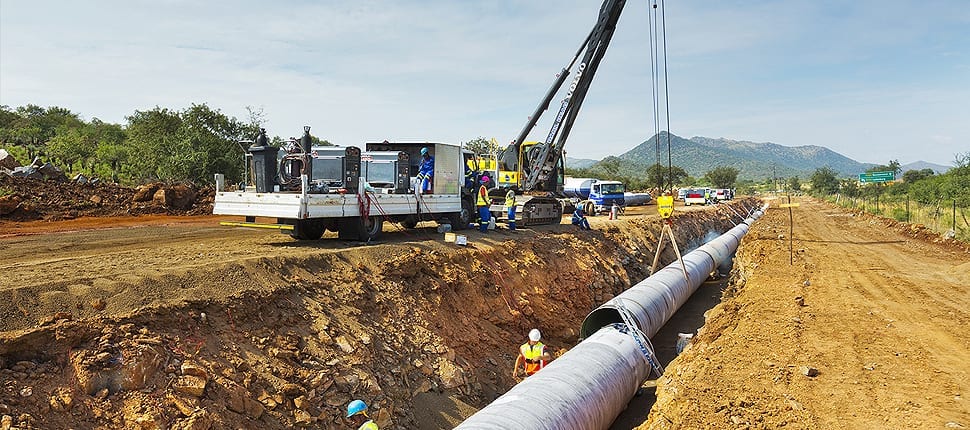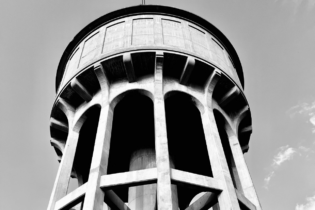Cabinet approved the project in 2004. Work on the De Hoop Dam started in 2007 when the then Minister of Water Affairs issued the Trans Caledon Tunnel Authority (TCTA) with a directive for the bulk distribution system in 2008. Design started in 2009, and construction on Sub-phase 2C started in 2012, with completion anticipated in 2017. The TCTA is the implementing agent for Sub-phase 2C and an Aurecon-Ndodana JV is the consulting engineer. Basil Read is the main contractor.
Were there any interesting challenges regarding the project? The pipeline passed through a number of communities. On a number of occasions, the pipeline project was on the receiving end of service delivery protests in the area. Even though we commenced the consultation process with neighboring communities about employment and business opportunities long before construction began, our project was still caught up in local issues. How were local employment opportunities created through the project? The contract required that certain employment targets be met, including that all unskilled labour and a certain percentage of skilled employees were to be sourced from the local areas surrounding the pipeline. This process was overseen by a collective community structure, called the project liaison committee (comprising two representatives from each community), whose members had the responsibility of reporting back to their respective communities. Other than the fact that the contractor met, and in some cases exceeded, the contractual requirement for procurement from and development of local enterprises, an additional R38 million was allocated for local business (from the project area) opportunities. Through our corporate social investment initiatives, the project rolled out the following projects: a pedestrian safety programme, aimed at schoolchildren, due to the high incidence of vehicle accidents with pedestrians; Passport to Future, for unemployed high school graduates in consultation with the water services authority (Sekhukhune District Municipality), and upgrading and developing water resources, like boreholes, at selected communities. Would it be possible to provide more background regarding the interesting features of this project? The Olifants River Water Resources Development Project Phase 2 (ORWRDP-2) is sited in the Olifants River catchment area, incorporating the Steelpoort River catchment area, and extending into the Mogalakwena and Sand River catchments. ORWRDP-2 comprises the following sub-phases: Sub-phase 2A entailed the construction of the De Hoop Dam on the Steelpoort River; Sub-phase 2B is a bulk distribution system from the Flag Boshielo Dam to the Mokopane area; and Sub-phase 2C, which I discussed earlier. Bulk infrastructure components include pipelines, pump stations, balancing reservoirs and a terminal reservoir at Pruissen. Sub-phases 2C, 2D, 2E and 2F cover a bulk distribution system from the De Hoop Dam that will ultimately link with the existing Olifants-Sand Transfer Scheme at Olifantspoort. Sub-phase 2H will entail the incorporation of portions of LWUA’s infrastructure into ORWRDP-2. What is the total cost of the project? Around R2 billion.
How do you eat an Olifants River Water Resources Development Project? The Department of Water and Sanitation (DWS) says, “One phase at a time.” Steven Arumugam, chief director: Infrastructure Development, DWS, provides an update on Phase 2’s 2C Sub-phase.
By Frances Ringwood
How long is the pipeline and what is its diameter?
SA For Sub-phase 2C, the steel pipeline is approximately 40 km long, with a diameter varying between 1.8 m and 1.3 m.
What community or industries will the pipeline benefit?
The water delivered by the pipeline is earmarked for social and commercial use (including mining and industry) in the Greater Tubatse Local Municipality.
How did these communities and industries receive water prior to the pipeline being constructed?
Generally, the communities received water through a series of boreholes and directly from the river. Water was also sourced from Flag Boshielo Dam on the Olifants River, by the mines, through a weir and pipeline scheme constructed by them under approval from the DWS. This is administered through the Lebalelo Water Users Association (LWUA).
How was the project funded?
This portion of the project is wholly funded from the fiscus.
Can you provide some details about the project timeline and background?









